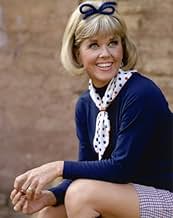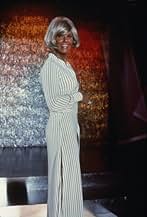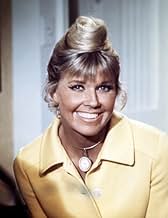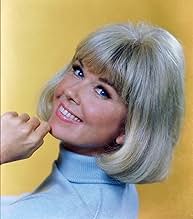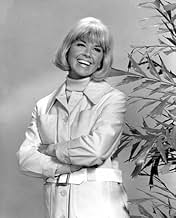Tras pasar la mayor parte de su vida en las grandes ciudades, la viuda Doris Martin decide volver al rancho familiar.Tras pasar la mayor parte de su vida en las grandes ciudades, la viuda Doris Martin decide volver al rancho familiar.Tras pasar la mayor parte de su vida en las grandes ciudades, la viuda Doris Martin decide volver al rancho familiar.
- Premios
- 2 nominaciones en total
Explorar episodios
Opiniones destacadas
I don't think this generation realizes how successful an actress and singer Doris Day was in the 50s and 60s (for starters). She starred in movies with some of the greatest leading men of the day. She was a talented jazz singer. She was a fashion icon. She seemed to have no 'dark side' or addictions. And then she had this television series.
From what I've read in scattered reviews of books about her, she didn't want to be a television actress. However, the ineptitude of her husband's managing her career put her so deep in debt that she had to perform in a television series because he had signed a contract obligating her to do so. Such is the danger of power of attorney!
Scriptwriters veered toward the sickeningly sweet dialogue and plots sometimes. When I watched the old 'Doris Day Show,' season 1, there was not much of that defect in the stories. Later, I think the writers fell into bad habits, but early on, Doris just seems to play Doris. That person is just a really nice person, one you love and want to know.
I enjoy seeing these old episodes of Season 1. Doris loves her animals and she loves her family! You would think these themes would be enough. Less talented writers forgot these important things but for a while, the series had the actress coming through as a very natural self, with high aspirations for her parenting role and a commitment to live on the ranch with her family. Nostalgic? Yes. But it's that lovely nostalgia that doesn't prompt you to laugh but instead miss all those 'family values' that used to rule television.
From what I've read in scattered reviews of books about her, she didn't want to be a television actress. However, the ineptitude of her husband's managing her career put her so deep in debt that she had to perform in a television series because he had signed a contract obligating her to do so. Such is the danger of power of attorney!
Scriptwriters veered toward the sickeningly sweet dialogue and plots sometimes. When I watched the old 'Doris Day Show,' season 1, there was not much of that defect in the stories. Later, I think the writers fell into bad habits, but early on, Doris just seems to play Doris. That person is just a really nice person, one you love and want to know.
I enjoy seeing these old episodes of Season 1. Doris loves her animals and she loves her family! You would think these themes would be enough. Less talented writers forgot these important things but for a while, the series had the actress coming through as a very natural self, with high aspirations for her parenting role and a commitment to live on the ranch with her family. Nostalgic? Yes. But it's that lovely nostalgia that doesn't prompt you to laugh but instead miss all those 'family values' that used to rule television.
You all know the backdrop of this series so I won't bore you with it. I love this show and I too like the season 2 and 3 shows the best. As far as format changes go, I think they did a really good job going from season 1 to 2 to 3. It was a logical progression, Doris gets a job, then she moves the family into town etc. I hate the way they changed the format in season 4 and 5. Had I been around at that time to put my two cents in I would have done several things. 1. In season 4 I would have left things exactly as they were in season three and brought in the Peter Lawford character as Doris's serious love interest and possible step father for the boys. This along with the normal goings on would have brought yet another logical advancement. 2. In season 5 I would have Doris and Peter get engaged, Doris gets a new Boss and is promoted to a staff writer position at the magazine. The season finale would have been Doris and Peter's wedding with the entire cast from all the seasons in attendance. This could have been a huge ratings getter and a great way to end the series. I just don't know what they were thinking when they did 4 and 5. There are some episodes that are good but the show is missing the heart it had in 1,2, and 3. As was stated by another poster we cant go back and change history but thankfully there is enough good in seasons 1 2 and 3 that I watch them all the time. A must for Doris Fans.
THE DORIS DAY SHOW (CBS, 1968-73), stars Doris Day in her only weekly comedy series. An actress whose screen career lasted twenty years (1948-1968), ranging from musicals, comedies and heavy dramas, at this point. By 1968, her career was virtually over, until finding herself working for the little screen called television.
THE DORIS DAY SHOW, premiering on CBS in September of 1968, opens with her signature theme song, "Que Sera Sera." The first season finds the widowed Doris Martin (Doris Day), living with her white haired, bearded father, Buck Webb (Denver Pyle) on the family ranch with her two blond-haired sons, Billy (Philip Brown) and Toby (Todd Starke), the little guy with a buck tooth. With similarities to the recent TV show, GREEN ACRES, Doris is a city girl now back on the farm. Supporting her father is the hired hand country boy, LeRoy B. Simpson (James Hampton). There's also a housekeeper, Aggie (Fran Ryan), and later Juanita (Naomi Stevens). The first season followed the tradition of other sit-coms of that time, sugar sweetness with country humor, never rising above the number one TV show of that time, THE ANDY GRIFFITH SHOW. The second season found Doris Martin still living on the farm, but now commuting to San Francisco and working as a secretary for Mr. Nicholson (MacLean Stevenson) at TODAY'S WORLD MAGAZINE. Also in support is Myrna Gibbons (Rose Marie, best known as Sally Rogers in THE DICK VAN DYKE SHOW). Rose Marie became an added plus in the show, although her character, a single woman always looking for the Mr. Right, was actually no different from her role on Van Dyke's show. Myrna and Doris were given a second banana character in the carnation of Ron Harvey (Paul Smith), a bachelor co-worker on the trail of beautiful female companionship. With this change, the show was slowly finding itself. For season three, Doris moves from her father's farm, taking her the boys and their sheepdog, Lord Nelson, to an apartment in San Francisco over an Italian restaurant run by Angie and Louie Palucci (Kaye Ballard and Bernie Kopell). Doris continues to work at TODAY'S WORLD MAGAZINE. Denver Pyle, no longer a series regular, appeared occasionally mostly in guest spots. While still working woman, Doris manages to find quality time with her boys. Up to this time, THE DORIS DAY SHOW improved, showing both humor and heart to the character and plots, but it was still trying to find itself.
As a youngster growing up during this period, I always enjoyed programs like this, especially whenever they included kids. The big change came with seasons four and five when Mrs. Doris Martin, still working at TODAY'S WORLD MAGAZINE and living in the same apartment on top of Palucci's Italian Restaurant, becomes Miss Doris Martin, a bachelor girl. The format shifted gears, eliminating the Martin boys, their dog, and contradicting everything from the previous seasons. Regardless, the show finally found itself. Of course there were occasional characters reprising their roles from the previous seasons, namely Kaye Ballard, Van Johnson and Billy DeWolfe (hilarious as Mr. Jarvis), so obviously this is the same character and same show with different format. Another difference, being true to life, is Doris now working as a staff writer for a new boss, Cy Bennett (the mustached John Dehner), supported by new co-worker pal, Jackie (Jackie Joseph). Changing her employer from a handsome and easy-going man to a stuffy middle-aged miser was a fine change, which found Doris at wits with her stingy boss. The final two seasons is the format that lasted the longest.
This new format would have worked had Doris Martin remained what she has been previously. Having the boys mentioned as being sent away to boarding school would have explained the emptiness of her apartment. It's surprising it wasn't renamed THE NEW DORIS DAY SHOW. What did happen was Doris Day succeeded in making this dramatic change work. For most, the working girl/family episodes from the second and third seasons are the best. The worst episodes are those with Doris as the only model in the annual fashion shows. A musical show showcasing Doris's fine singing voice would have been preferable, almost as nostalgic as the two Christmas episodes (1970 and 1971) which made them so enjoyable. One episode I remember most but like the least is "Young Love" from Season Three, where Doris appears in the opening segment, comforting a troubled teen named April (played by Meredith Baxter), who tells her story via flashback, taking up the entire episode. In Seasons Four and Five, Doris Martin found a romantic love interest, a middle-aged doctor, played by silver-haired Peter Lawford.
An episode, which I feel might be the one closest to Doris Day's heart, is the one in which she goes on trial for releasing a group of dogs locked in an automobile parked in the hot sun with shut windows. After being taken to court by the owner, she, of course, gets acquitted following her plea in the courtroom for the safety of dogs and other creatures, and her willingness to do what she did again even if it meant serving jail time. No doubt this could be Doris Day's personal favorite since it's more Doris Martin being Doris Day, an animal rights activist.
All episodes of THE DORIS DAY SHOW were produced on film and in color. Interestingly, seldom revived in syndication. Unseen on cable since the 1980s, all 128 episodes are currently available on DVD.
THE DORIS DAY SHOW, premiering on CBS in September of 1968, opens with her signature theme song, "Que Sera Sera." The first season finds the widowed Doris Martin (Doris Day), living with her white haired, bearded father, Buck Webb (Denver Pyle) on the family ranch with her two blond-haired sons, Billy (Philip Brown) and Toby (Todd Starke), the little guy with a buck tooth. With similarities to the recent TV show, GREEN ACRES, Doris is a city girl now back on the farm. Supporting her father is the hired hand country boy, LeRoy B. Simpson (James Hampton). There's also a housekeeper, Aggie (Fran Ryan), and later Juanita (Naomi Stevens). The first season followed the tradition of other sit-coms of that time, sugar sweetness with country humor, never rising above the number one TV show of that time, THE ANDY GRIFFITH SHOW. The second season found Doris Martin still living on the farm, but now commuting to San Francisco and working as a secretary for Mr. Nicholson (MacLean Stevenson) at TODAY'S WORLD MAGAZINE. Also in support is Myrna Gibbons (Rose Marie, best known as Sally Rogers in THE DICK VAN DYKE SHOW). Rose Marie became an added plus in the show, although her character, a single woman always looking for the Mr. Right, was actually no different from her role on Van Dyke's show. Myrna and Doris were given a second banana character in the carnation of Ron Harvey (Paul Smith), a bachelor co-worker on the trail of beautiful female companionship. With this change, the show was slowly finding itself. For season three, Doris moves from her father's farm, taking her the boys and their sheepdog, Lord Nelson, to an apartment in San Francisco over an Italian restaurant run by Angie and Louie Palucci (Kaye Ballard and Bernie Kopell). Doris continues to work at TODAY'S WORLD MAGAZINE. Denver Pyle, no longer a series regular, appeared occasionally mostly in guest spots. While still working woman, Doris manages to find quality time with her boys. Up to this time, THE DORIS DAY SHOW improved, showing both humor and heart to the character and plots, but it was still trying to find itself.
As a youngster growing up during this period, I always enjoyed programs like this, especially whenever they included kids. The big change came with seasons four and five when Mrs. Doris Martin, still working at TODAY'S WORLD MAGAZINE and living in the same apartment on top of Palucci's Italian Restaurant, becomes Miss Doris Martin, a bachelor girl. The format shifted gears, eliminating the Martin boys, their dog, and contradicting everything from the previous seasons. Regardless, the show finally found itself. Of course there were occasional characters reprising their roles from the previous seasons, namely Kaye Ballard, Van Johnson and Billy DeWolfe (hilarious as Mr. Jarvis), so obviously this is the same character and same show with different format. Another difference, being true to life, is Doris now working as a staff writer for a new boss, Cy Bennett (the mustached John Dehner), supported by new co-worker pal, Jackie (Jackie Joseph). Changing her employer from a handsome and easy-going man to a stuffy middle-aged miser was a fine change, which found Doris at wits with her stingy boss. The final two seasons is the format that lasted the longest.
This new format would have worked had Doris Martin remained what she has been previously. Having the boys mentioned as being sent away to boarding school would have explained the emptiness of her apartment. It's surprising it wasn't renamed THE NEW DORIS DAY SHOW. What did happen was Doris Day succeeded in making this dramatic change work. For most, the working girl/family episodes from the second and third seasons are the best. The worst episodes are those with Doris as the only model in the annual fashion shows. A musical show showcasing Doris's fine singing voice would have been preferable, almost as nostalgic as the two Christmas episodes (1970 and 1971) which made them so enjoyable. One episode I remember most but like the least is "Young Love" from Season Three, where Doris appears in the opening segment, comforting a troubled teen named April (played by Meredith Baxter), who tells her story via flashback, taking up the entire episode. In Seasons Four and Five, Doris Martin found a romantic love interest, a middle-aged doctor, played by silver-haired Peter Lawford.
An episode, which I feel might be the one closest to Doris Day's heart, is the one in which she goes on trial for releasing a group of dogs locked in an automobile parked in the hot sun with shut windows. After being taken to court by the owner, she, of course, gets acquitted following her plea in the courtroom for the safety of dogs and other creatures, and her willingness to do what she did again even if it meant serving jail time. No doubt this could be Doris Day's personal favorite since it's more Doris Martin being Doris Day, an animal rights activist.
All episodes of THE DORIS DAY SHOW were produced on film and in color. Interestingly, seldom revived in syndication. Unseen on cable since the 1980s, all 128 episodes are currently available on DVD.
"Raysond" wrote this in his/her review: "due to low ratings and a sorry time slot) to let it go and from there "The Doris Day Show" was canceled by CBS. Also during this time the career of singer/actress/producer Doris Day was over and to this day in 1973 officially retired from the entertainment industry where she is living peacefully somewhere in her private estate in Hollywood."
Nothing could be far from the truth. Yes, CBS dealt Doris Day a "Ft. Knox Hand" (that's what VARIETY called it) to Miss Day for her to do a TV series. But, unlike what was reported by Raysond, the series was consistently in the Top 20 it's entire run. Doris Day called it quits with CBS. She had never wanted to do television in the first place: her husband secretly signed her to the CBS contract without her permission. He died, and as Day has said, "I was delivered to CBS." From what I have read, CBS wanted Doris to re-sign and continue the show, but she declined. She did, however, live up to her contract and did the two musical specials that her late husband promised.
Most people are not aware, but Doris' film career was far from over in 1968. Her three films that year ("Ballad of Josie," "Where Were You When The Lights Went Out" and "With Six You Get Eggroll") should have landed her among the top ten box office stars, but with the news that she would be doing a TV show, Quigley's Poll didn't bother. The fact is, Doris Day's 1968 films out-grossed several of the stars who made the list.
Nothing could be far from the truth. Yes, CBS dealt Doris Day a "Ft. Knox Hand" (that's what VARIETY called it) to Miss Day for her to do a TV series. But, unlike what was reported by Raysond, the series was consistently in the Top 20 it's entire run. Doris Day called it quits with CBS. She had never wanted to do television in the first place: her husband secretly signed her to the CBS contract without her permission. He died, and as Day has said, "I was delivered to CBS." From what I have read, CBS wanted Doris to re-sign and continue the show, but she declined. She did, however, live up to her contract and did the two musical specials that her late husband promised.
Most people are not aware, but Doris' film career was far from over in 1968. Her three films that year ("Ballad of Josie," "Where Were You When The Lights Went Out" and "With Six You Get Eggroll") should have landed her among the top ten box office stars, but with the news that she would be doing a TV show, Quigley's Poll didn't bother. The fact is, Doris Day's 1968 films out-grossed several of the stars who made the list.
When I was a kid this was my first exposure to Doris Day. I was only two when this show first aired and I used to watch it every week. However, it was fairly confusing due to the fact that it changed situations almost every season. In the first season she was the typical widowed mom raising her two kids in an almost carbon copy of "Green Acres", but without the surrealism of that show. In the second season we see her become a writer for a magazine, which she would remain, with slight variations for the next few years. However, in the final season, the show pretty much becomes another version of "Mary Tyler Moore" with her now playing a single girl and without the kids that she had for the first few years. However, despite these changes Doris Day retained the charm and grace that made her one of the most popular stars in television.
Also, one thing that is quite ironic is the fact that this show was set in San Francisco, which was the same locale as her former co-star, and close friend, Rock Hudson's series "McMillan and Wife". That fact could have led to all sorts of guest star possibilities.
Also, one thing that is quite ironic is the fact that this show was set in San Francisco, which was the same locale as her former co-star, and close friend, Rock Hudson's series "McMillan and Wife". That fact could have led to all sorts of guest star possibilities.
¿Sabías que…?
- TriviaDoris Day's contract with CBS to do this series set a record, with her production company getting several million dollars in up-front money. It was negotiated by Martin Melcher, her husband of 17 years. However, after Melcher died unexpectedly in April of 1968, just five months before the series was to debut, Day said she had no knowledge of ever having signed on to do the show. It turned out that Melcher and the couple's lawyer and financial advisor had squandered the millions of dollars that Day had made in her 20-year career in films and records, leaving her not only flat broke but also more than $500,000 in debt. Melcher, desperate for money, had used his position as her husband and manager and had contracted with CBS to produce a sitcom for Day, but he never told her about it.
- ConexionesFeatured in Biography: Doris Day: It's Magic (1998)
Selecciones populares
Inicia sesión para calificar y agrega a la lista de videos para obtener recomendaciones personalizadas
- How many seasons does The Doris Day Show have?Con tecnología de Alexa
Detalles
- Fecha de lanzamiento
- País de origen
- Idioma
- También se conoce como
- El show de Doris Day
- Locaciones de filmación
- 650 California Street, San Francisco, California, Estados Unidos(Today's World magazine office)
- Productora
- Ver más créditos de la compañía en IMDbPro
Contribuir a esta página
Sugiere una edición o agrega el contenido que falta

Principales brechas de datos
By what name was The Doris Day Show (1968) officially released in India in English?
Responda
